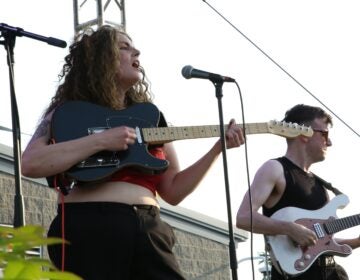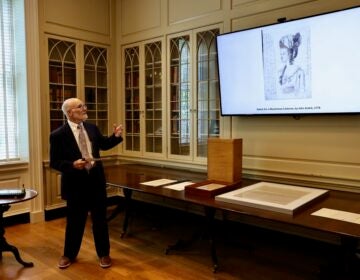Moore offers graphic look at creative chaos of punk
ListenOriginal graphic designs from the Cramps, the Clash, X-Ray Spex, the Ramones, Black Flag and countless others are wallpapering the galleries of Moore College of Art and Design in Philadelphia.
“Pretty Vacant” includes hundreds of posters, fliers, album covers, buttons, and badges from the early days of the NYC and London punk scene, and later post-punk years, all from the collection of Andrew Krivine.
Krivine began collecting punk stuff as a teenager, splitting his time between London and New York City in the late ’70s and ’80s. During summers he would visit his cousin who owned a fashion store on Kings Road — called Boy — that was part of the burgeoning punk movement.
Krivine would frequent the 100 Club and the Vortex, then return to New York City to check out CBGB’s and Max’s Kansas City. All the while, he was picking up fliers, buttons and posters.
“Pretty Vacant” features, on the one hand, sophisticated designers including Pete Saville, who designed album covers for Joy Division; Barney Bubbles, who designed for Nick Lowe and Elvis Costello; and Raymond Pettibon, who created the iconic logo for the band Black Flag.
There are also fliers by unknown artists, depicting what songwriter Mark Eitzel called “anonymous scenes of disaffection, chaos, and torture.”
“I think a lot of people have not seen all this stuff together in one grouping before,” said Moore curator Kaytie Johnson, who spent some of her youth in the punk scene of Phoenix.
“They’ve seen a random flier, a poster here and there. But when you can see everything together, then you can see it on a grander scale, and step away from the nostalgia,” she said.
The many layers of Tattooed Mom
Philadelphia has its own unofficial repository of punk graphics — the upstairs of Tattooed Mom, a bar on South Street. The walls are covered in posters, fliers, and graffiti that has been piling up for almost 20 years.
“The beautiful thing about this place — everything is layers,” said Dennis McHugh, a regular, pointing to original “Obey” wheat-paste posters by Shepard Fairey, obscured by the scrawls of later artists.
McHugh is a longtime figure on the Philadelphia punk scene, arriving downtown in 1977, at age 17, with a job at a print shop at 12th and Arch streets. He made countless fliers for shows for places like the Kennel Club, the East Side Club, the Love Club, the Hot Club, for bands like the Stickmen, YDI, and F.O.D.
He was best at the cut-and-paste method, collaging images of — for example — ax-wielding figures among a field of disembodied women’s heads. That was for his old band the Butcher Brothers.
“I just did things that grabs somebody’s attention,” said McHugh, flipping through a box of old fliers. “Butchers standing over ladies, with screaming heads. You can’t walk down the street, if that’s on a pole, and not see it.”
His latest promotional effort is for the band Ruin, an art-punk band from the early ’80s that occasionally reunites for shows and re-releases. Ruin would not only make their own fliers, they would photocopy handouts for everyone who came to the show.
“It always struck us that songs have lyrics, and you put a lot into the lyrics, but no one can understand them,” said guitarist Glenn Wallis. “It was a way of slowing things down and articulating something that was part of what the music was about, but often got lost in live performance and the powerful sound.”
Wallis said the fliers were meant to be propaganda. Ruin was a Buddhist band, and most of the members had a regular meditation practice or were interested in Zen mindfulness. The hand-written fliers included philosophical ideas, poetry, and whatever the band was thinking about at the time.
“We had flier campaigns even before we had a band,” said Wallis. “I was really inspired by Situationists and Dada, and the Surrealists. That was all very inspiring to me. My brother and I would write out a compelling statement, and a picture, and we’d plaster them throughout the city.”
This is the early 1980s, a time when Margaret Thatcher and Ronald Reagan, together, gave birth to hundreds if not thousands of punk bands. In Philadelphia, the subgenre was already fractioning.
A comic take on the times
“The scene was already changing from punk — which was anything goes, very wild, artistic — to hardcore, which was very limited, narrow, and more conservative,” said Elizabeth Fiend of the band More Fiends.
Fiend (Elizabeth Moersh, legally) drew comics. She was known for a series called “The Young and the Frustrated,” which ran in hundreds of alternative magazines and newspapers. She drew stories centered on punk girls. The comics were often sexually graphic, sometimes deemed pornographic.
Fiend made the comics into small booklets and gave them away at punk shows.
“At the end of the night, I could take an assessment to see how many of the comics were on the floor, stomped with Doc Martin footprints,” said Fiend. “If it was a punk show — not a straightforward hardcore show, but a more imaginative punk band — there would be no papers on the floor. If it was a hardcore show, than the floor would be littered with cartoons.”
“The Young and the Frustrated” ran for more than 10 years, but stopped cold in the late-’80s, during the culture wars. Editors grew skittish when federal agencies, propelled by politicians including Jesse Helms, went after distributors and retailers of explicit material.
Now, sitting in the third-floor office of her South Philadelphia rowhome, Fiend says punk may not be what it used to be, but it’s not dead.
“The hipsters that are apparently moving here from Brooklyn and ‘taking over’ — in quotes — they might not be punk, but they like irony and juxtaposition,” said Fiend. “A lot of the aesthetic styles I was fond of, they adapted and mellowed out a little bit. But the same philosophy is present.”
The work of Elizabeth Fiend is not featured in the punk graphic design show at Moore College. However the work by her contemporaries will be seen by all those art student “hipsters” — in quotes.
WHYY is your source for fact-based, in-depth journalism and information. As a nonprofit organization, we rely on financial support from readers like you. Please give today.




















